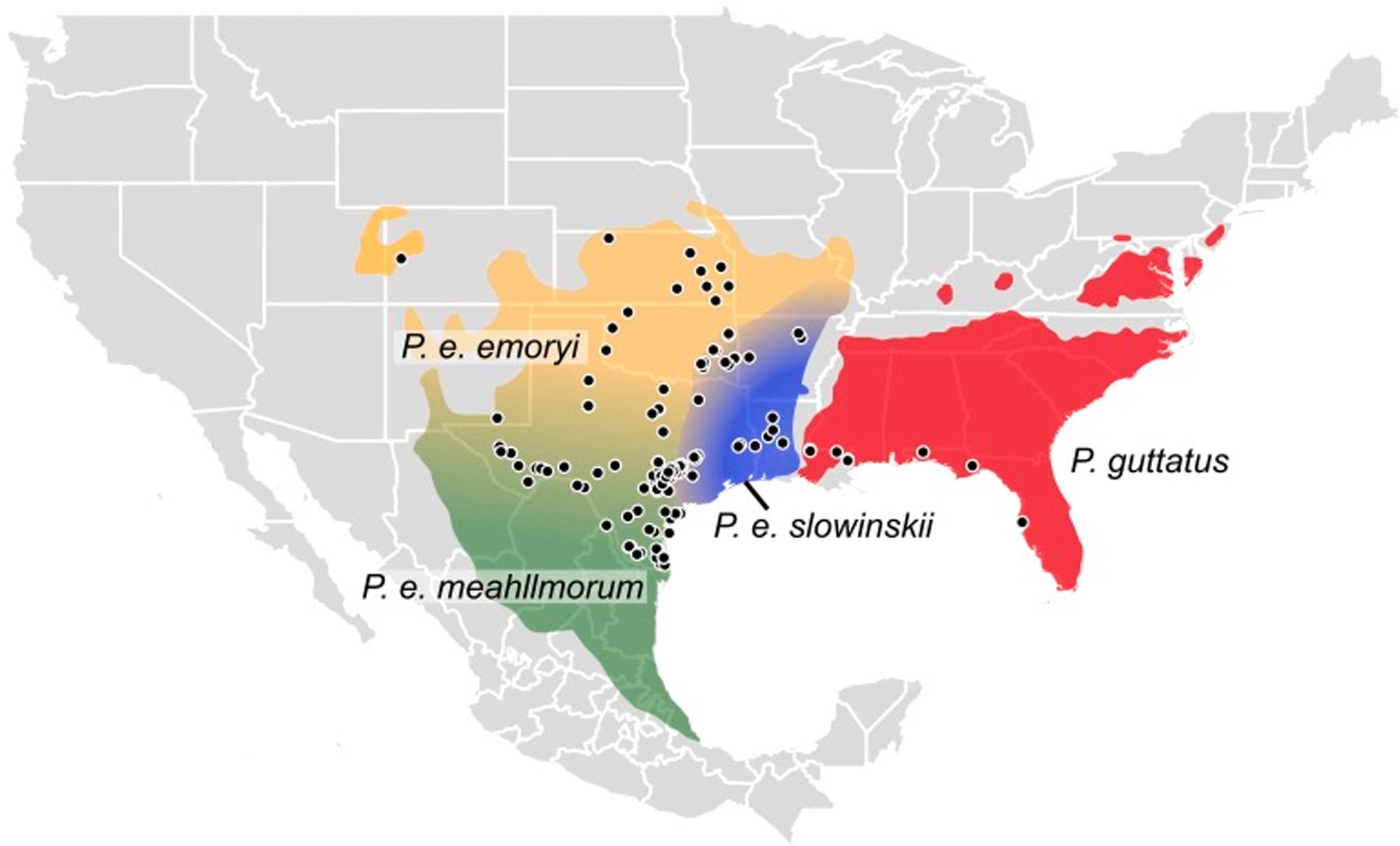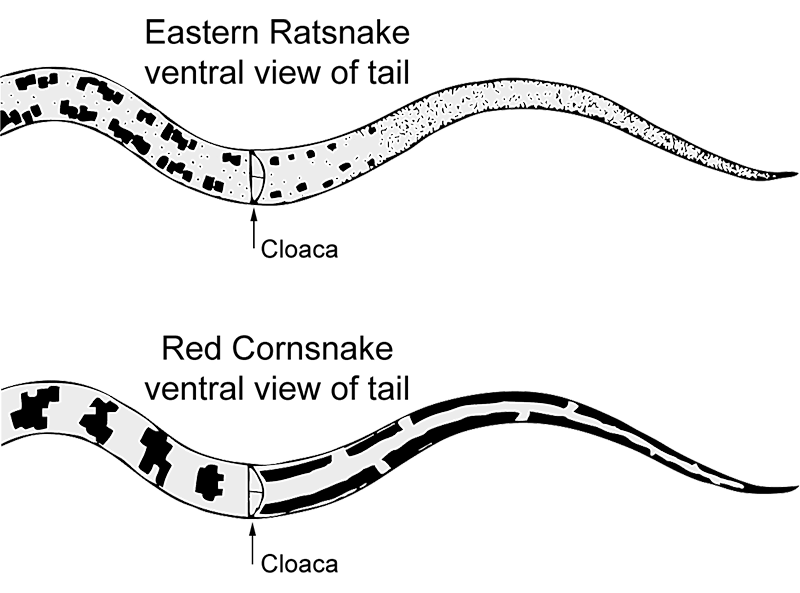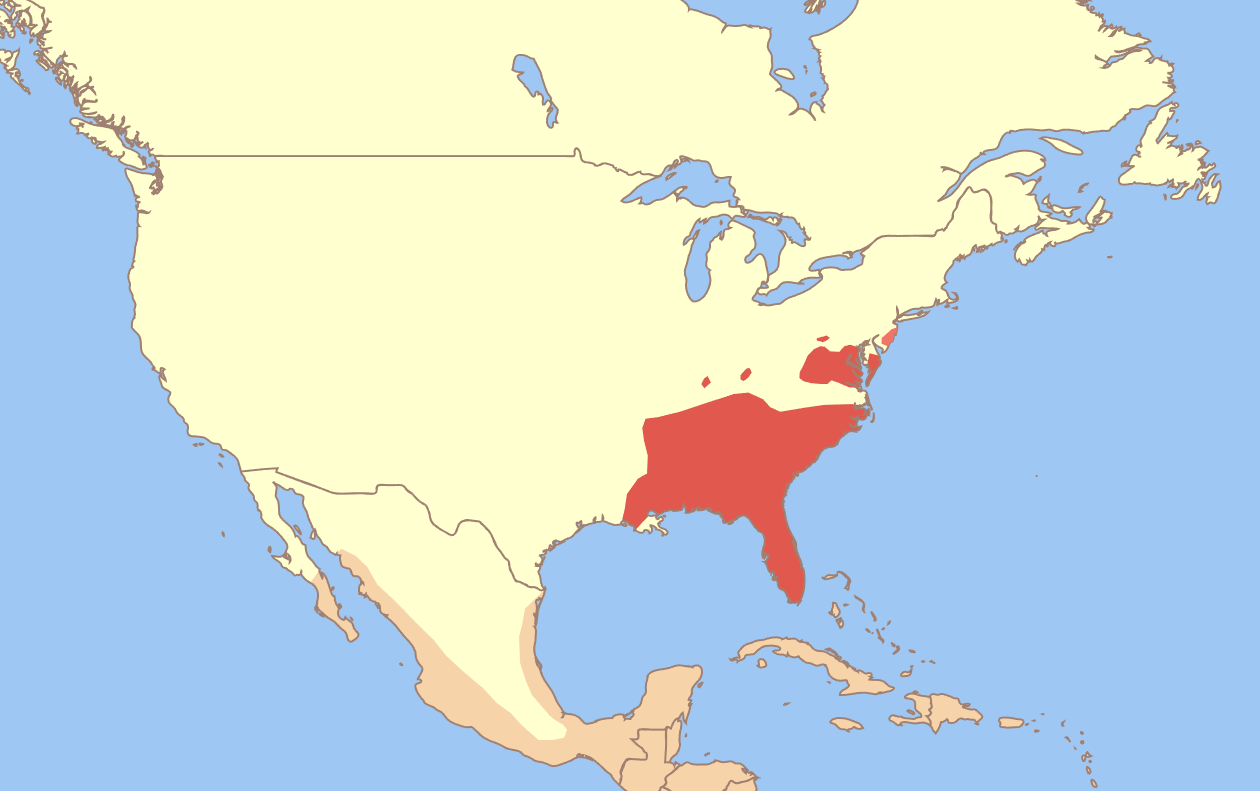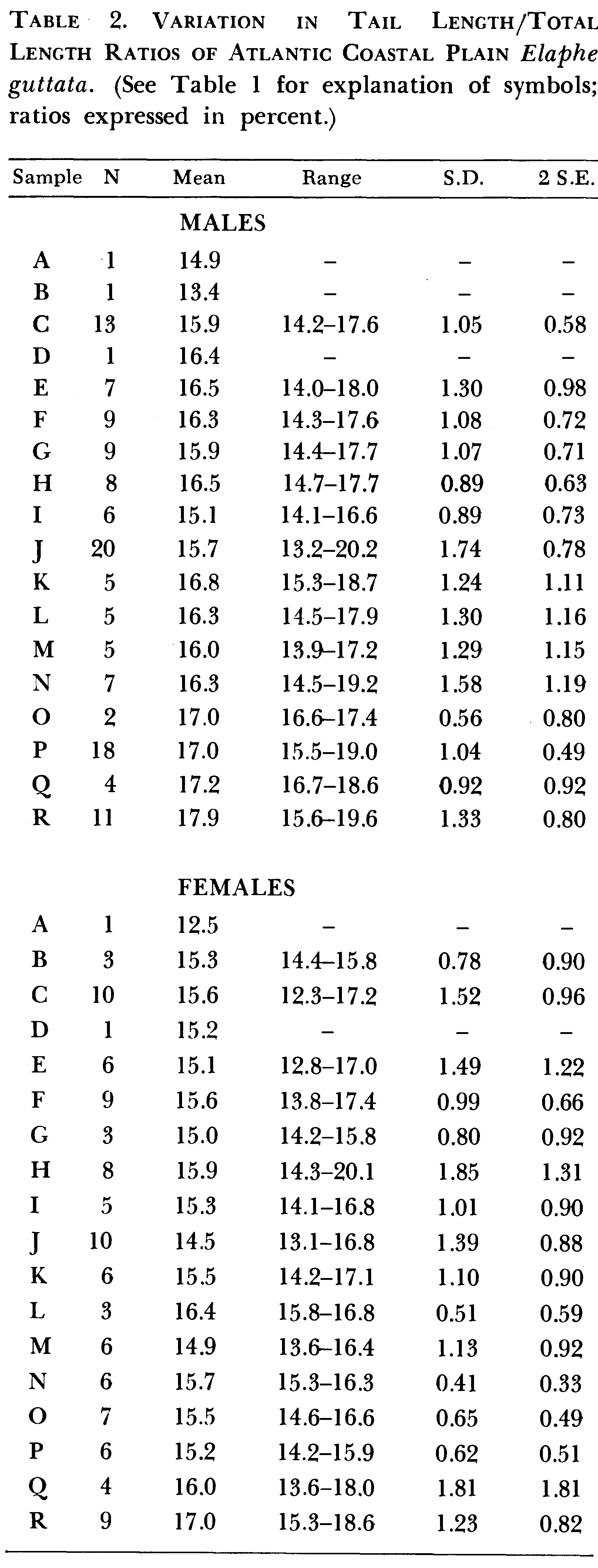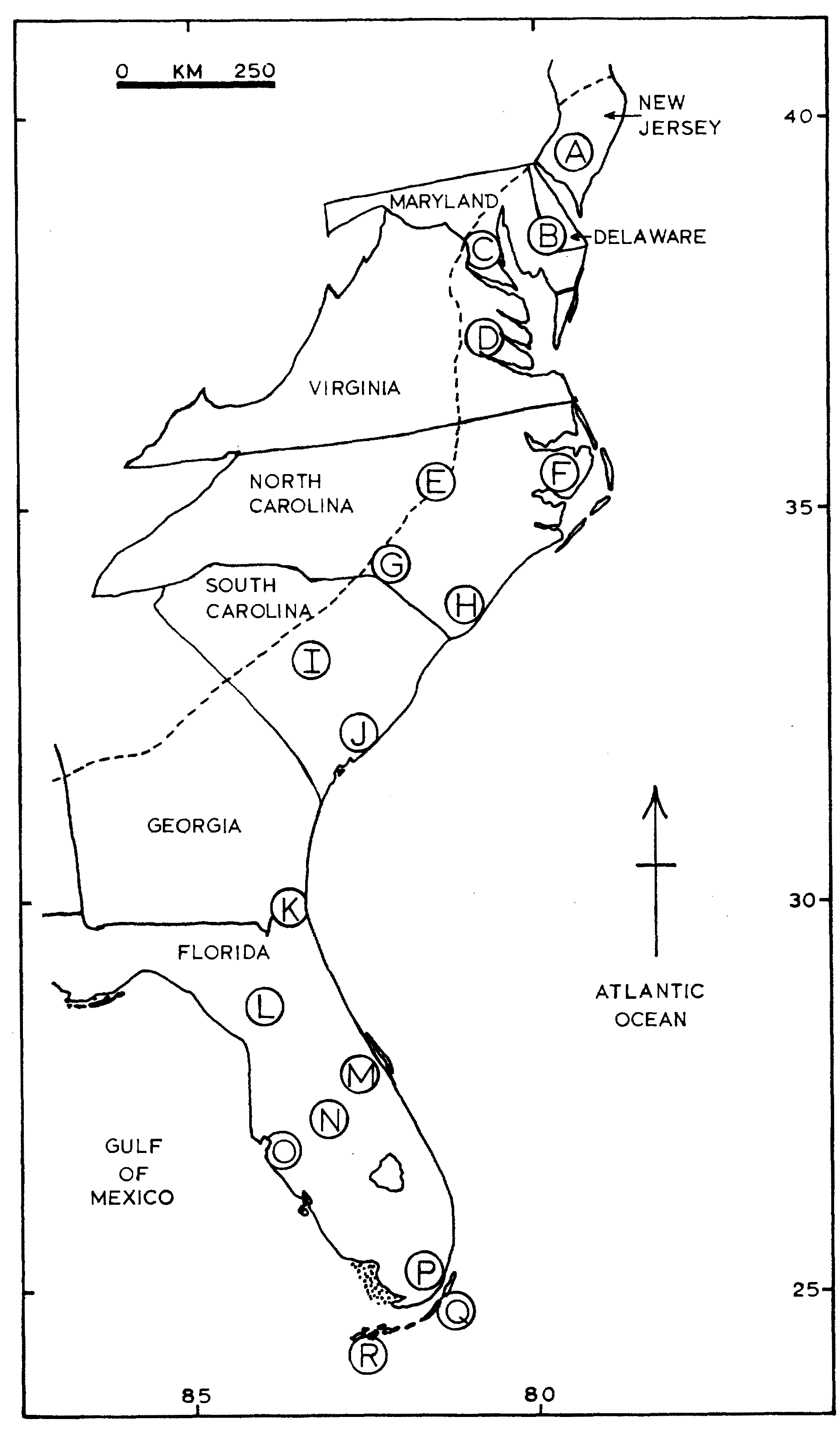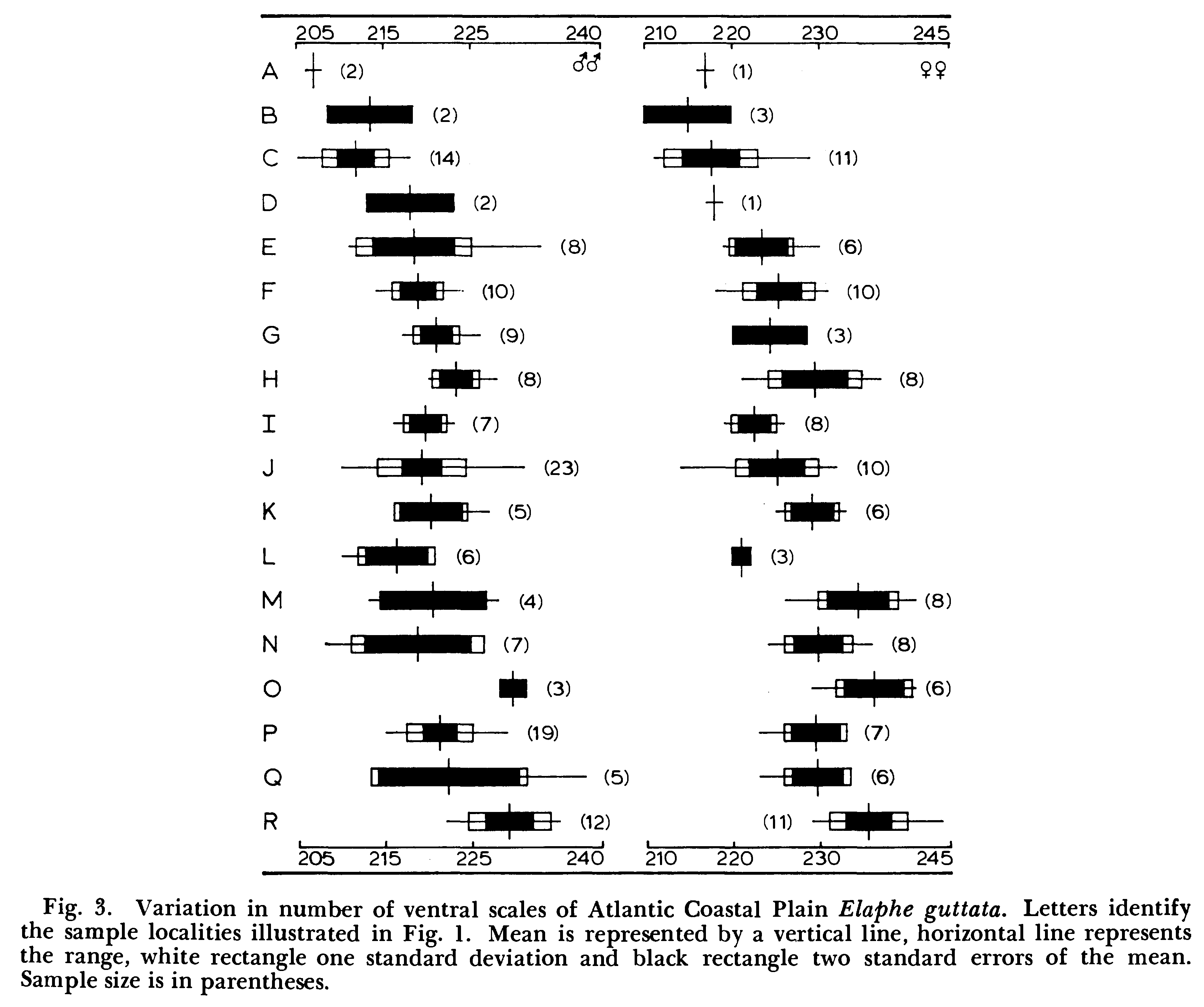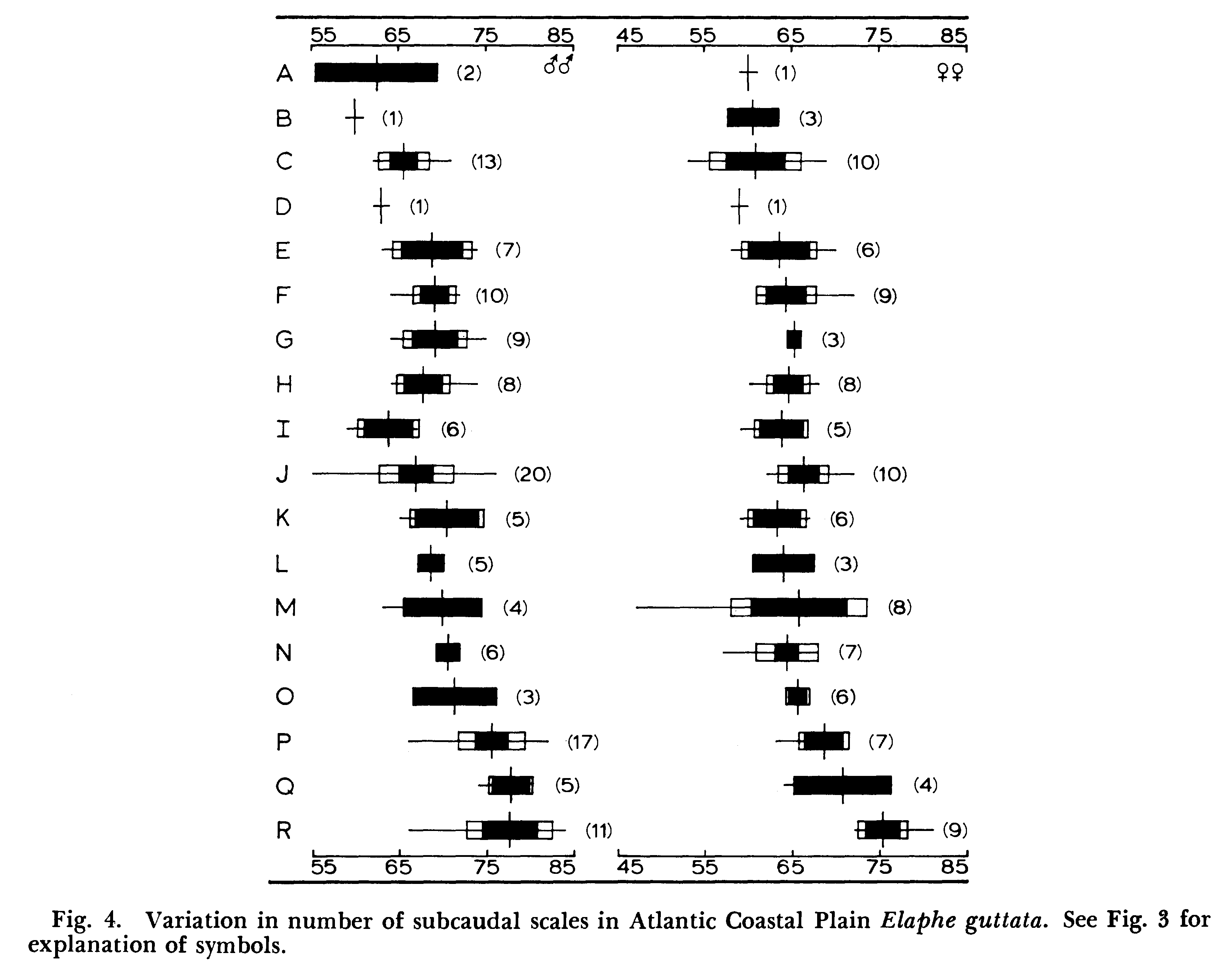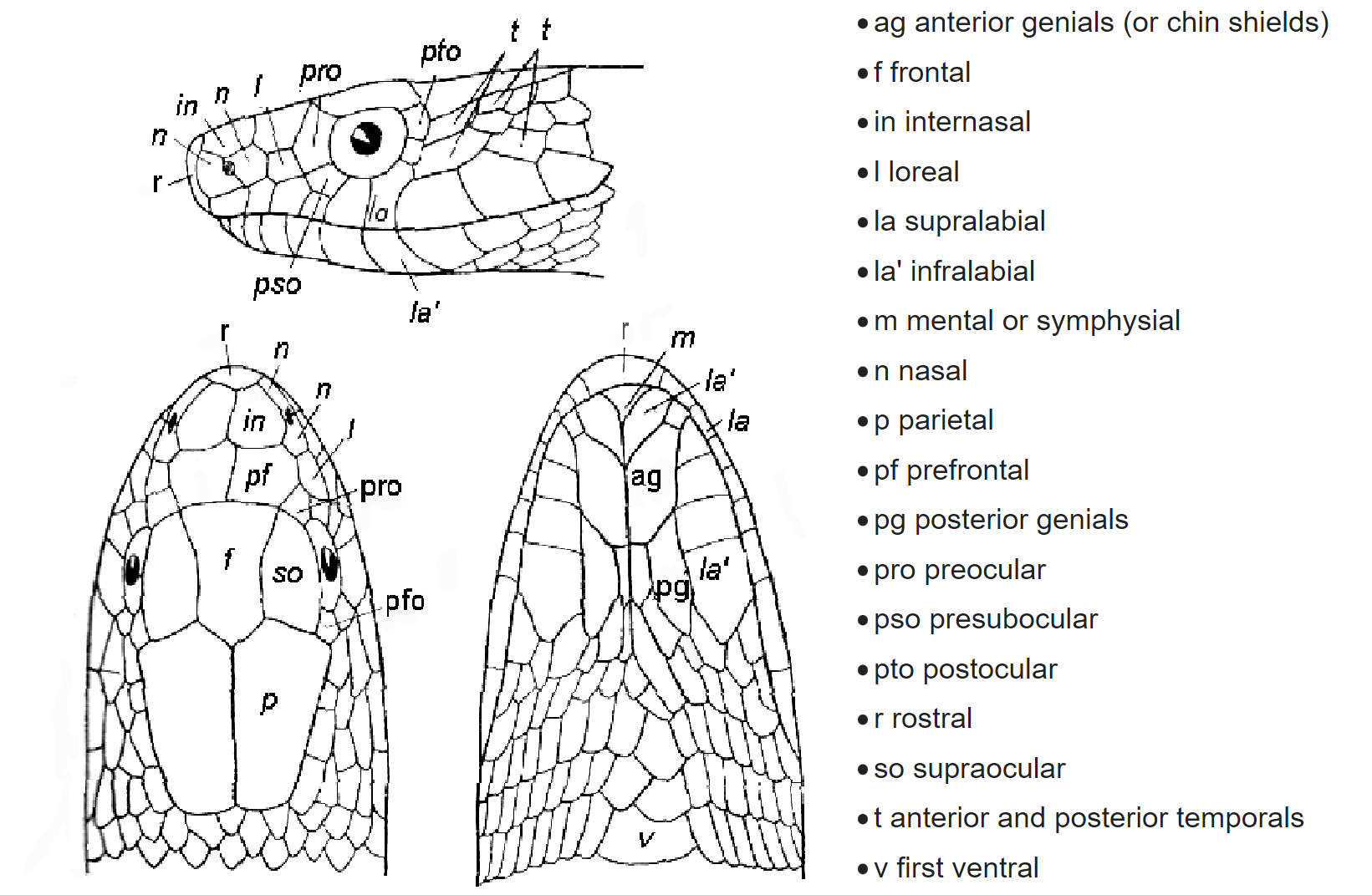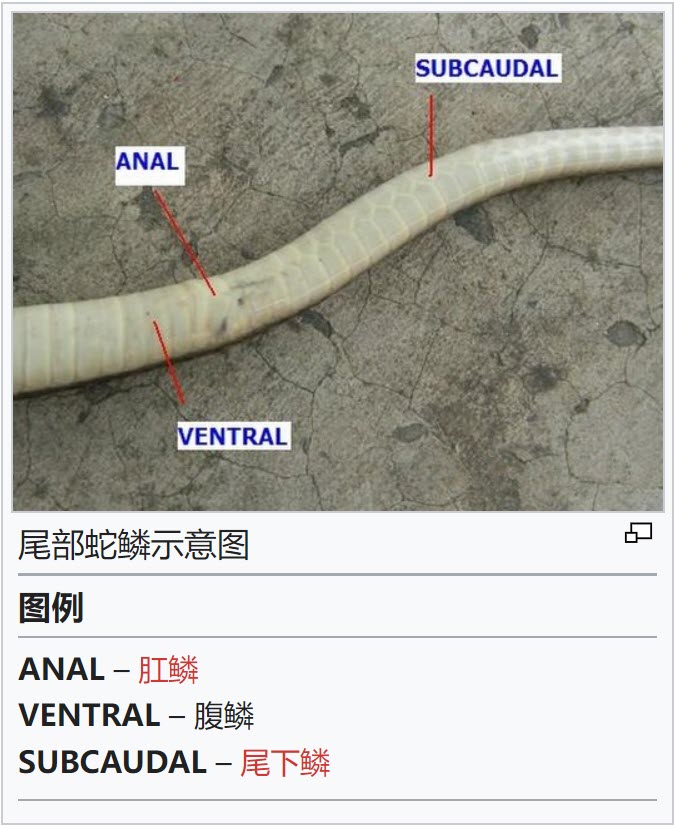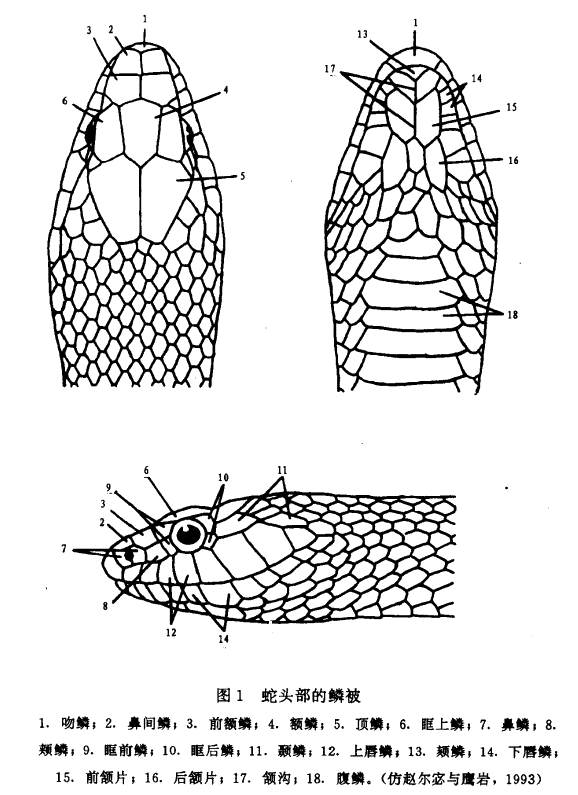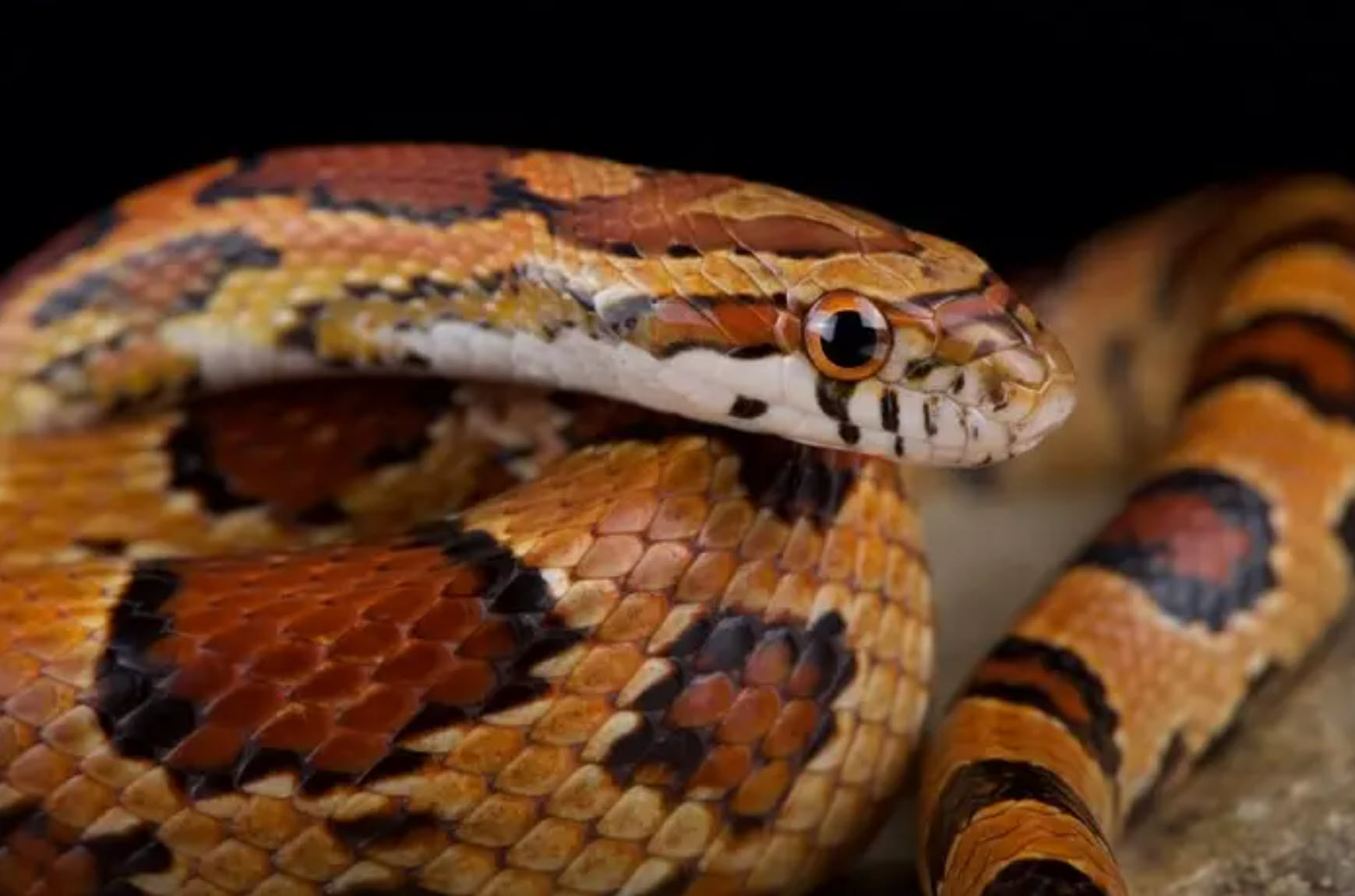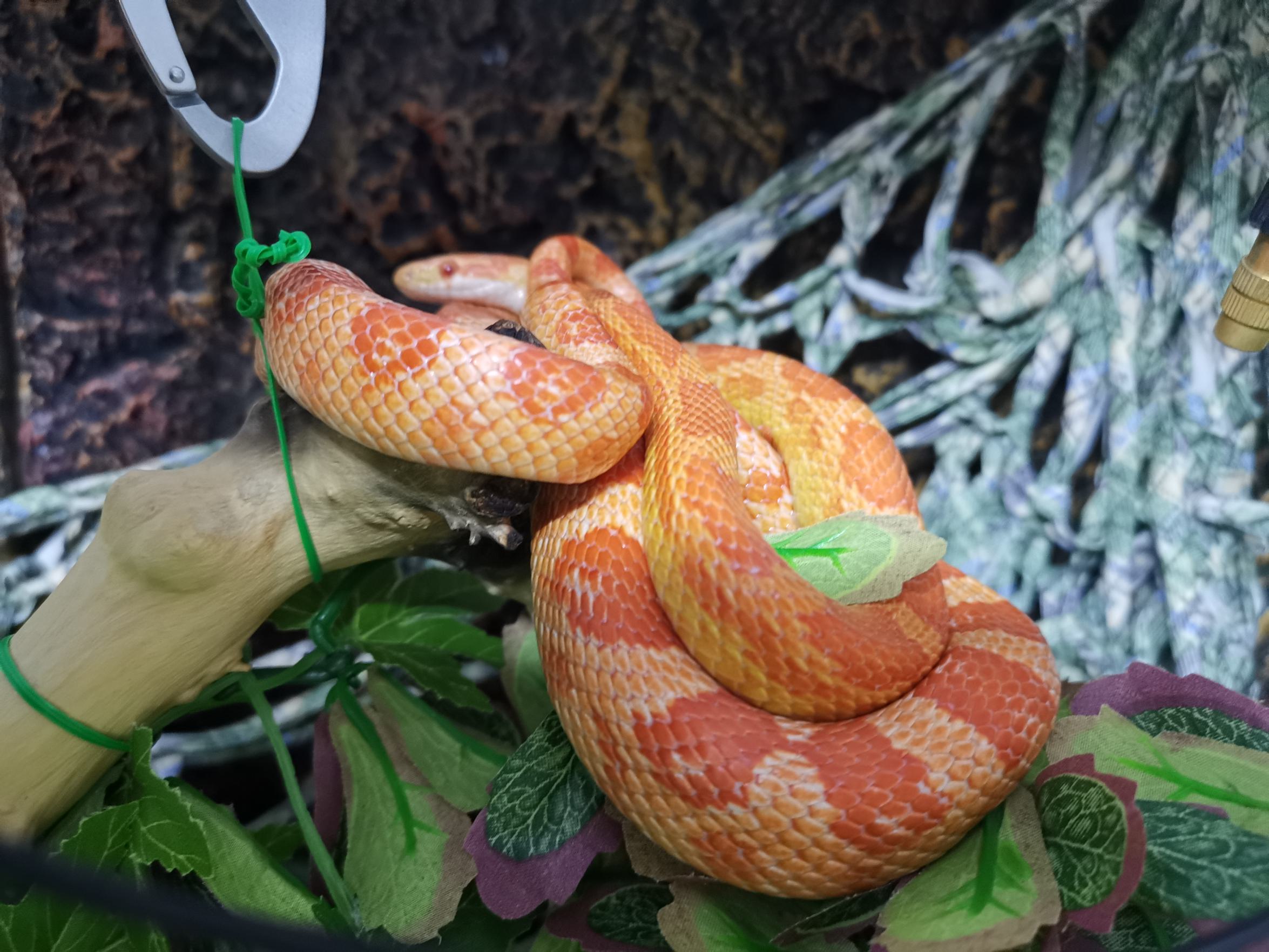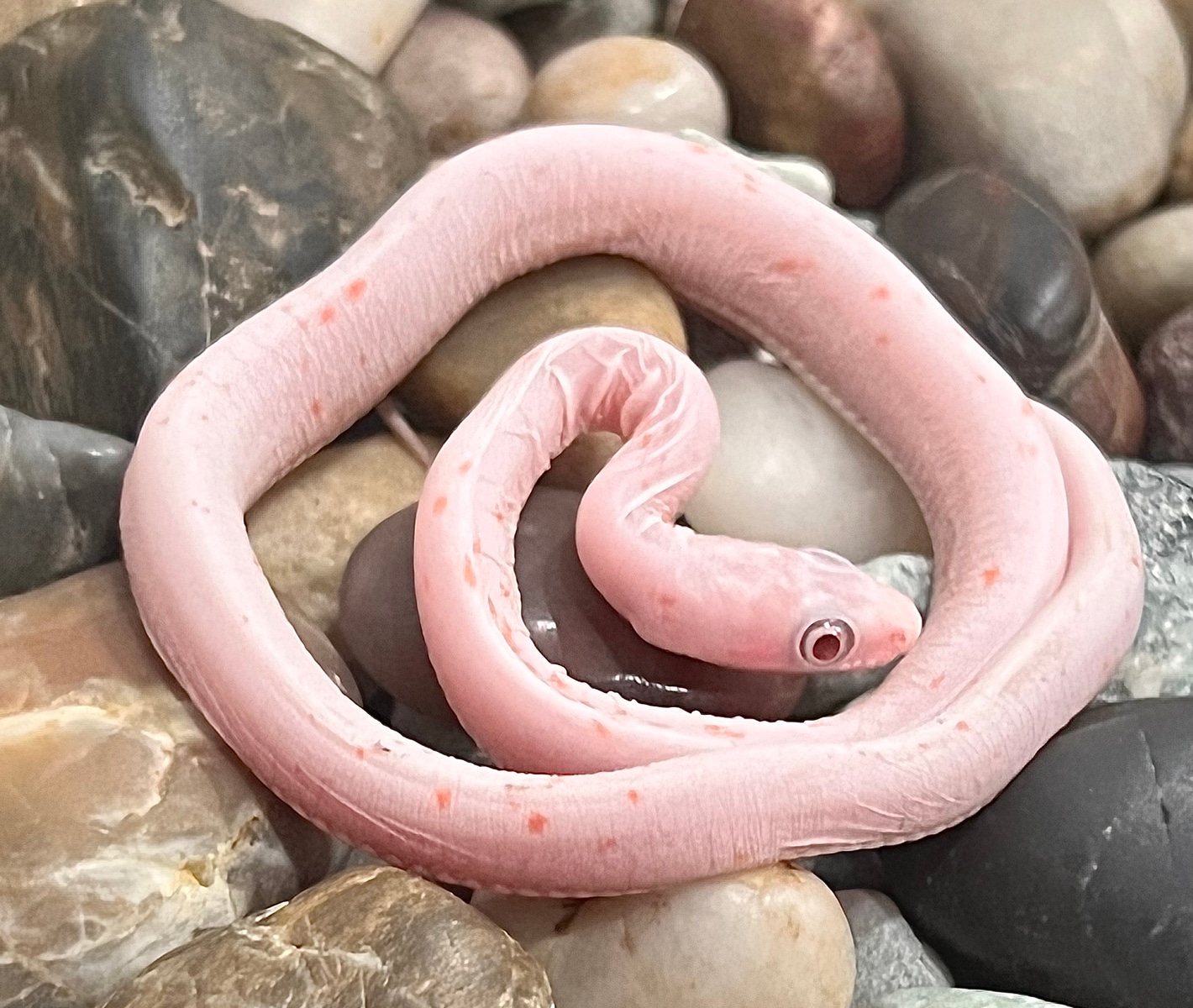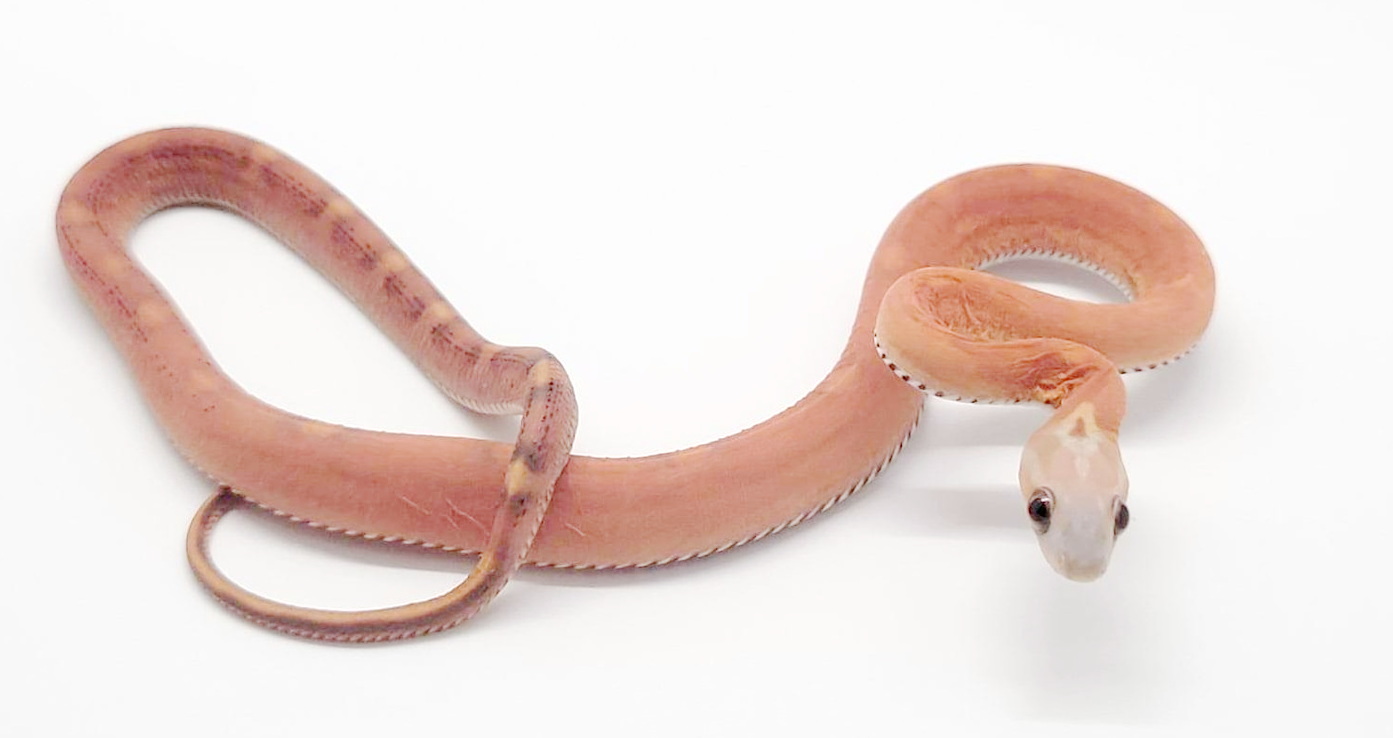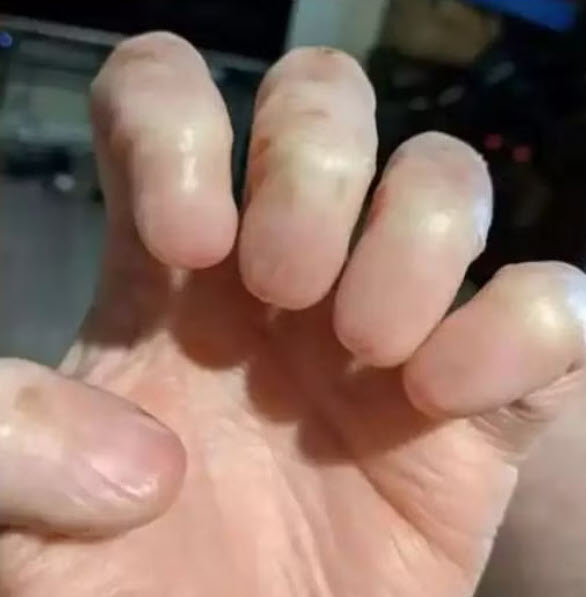- 玉米蛇宠物饲养询证指南
- 说明
- 本指南建设原则
- 入手前需要什么
- 基本物种信息
- 解剖与生理
- 动物福利总论
- 蛇的行为学
- 爬行动物的认知能力
- 丰容
- 玉米蛇的自然生境
- 玉米蛇饲养的要素
- 空间需求
- 栖地布置总则
- 光照与加热
- 光照的测试
- 湿度
- 垫材
- 攀爬、遮挡与躲避
- 水
- 食物
- 共栖关系
- 蜕皮
- 特殊状态:冬眠和繁殖
- 互动与行为训练
- 运输
- 摄像头
- 伏地魔栖地
- 应急预案
- 蛇的医疗
- 信息来源
- 其他问题
- 词汇表
- 其他物种
(以及这些信息有什么用)
- Corn snake 玉米蛇/玉米锦蛇(因为玉米蛇经常出现在玉米仓里,所以美国农民以为它吃玉米,其实只是玉米仓里鼠患严重,玉米蛇来吃老鼠罢了。奶蛇milk snake的命名也有类似的故事。)
- Red rat snake 红鼠蛇(玉米蛇属于鼠蛇,野生型棕红色)
- Kornnatter(德语)
单独查玉米蛇有时资料太少,必须参考其他蛇类的资料。分类有多近是衡量可参考性高低的一个角度。
- 爬行纲 Reptilia
- 有鳞目 Squamata
- 蛇亚目 Serpentes
- 新蛇次亚目 Caenophidia
- Colubroides 演化支
- 游蛇总科 Colubroidea
- 游蛇科 Colubridae
- 黄颌蛇亚科 Colubrinae
- 豹斑蛇属 Pantherophis
- 玉米蛇 Pantherophis guttatus
词源:Panther- 像豹子的(有豹纹的),-ophis 蛇,guttatus 有斑纹的
分类学变更会导致物种名称变化,也可能导致相同的物种名指代不同的群体。因此研究时需要了解分类学变更历史。
Reptile database上可以查找各种爬行动物的分类学、其变更历史及其下辖亚种。下面简述相关的分类学变动过程。
自1917年来,现在定义上的玉米蛇一只属于物种Elaphe guttata(Dunn ![]() )IV ,包括本指南所引用的部分文献在内的许多较早文献还要用Elaphe guttata这个名词才能查到:
)IV ,包括本指南所引用的部分文献在内的许多较早文献还要用Elaphe guttata这个名词才能查到:
- 游蛇亚科 Colubrinae
- 锦蛇属 Elaphe
- 玉米锦蛇 Elaphe guttata
- 玉米锦蛇指名亚种 Elaphe guttata guttata
- 玉米锦蛇rosacea亚种 Elaphe guttata rosacea
- 玉米锦蛇埃莫里亚种 Elaphe guttata emoryi
- 玉米锦蛇intermontanus亚种 Elaphe guttata intermontanus
- 玉米锦蛇meahllmorum亚种 Elaphe guttata meahllmorum
- 玉米锦蛇 Elaphe guttata
- 锦蛇属 Elaphe
2002年Burbrink等人用分子生物学工具分析线粒体DNA和细胞色素B的DNA序列,得出旧物种Elaphe guttata已因为排它的地理隔离演化为三个独立物种:玉米锦蛇 Elaphe guttata, 斯洛文斯基锦蛇 Elaphe slowinskii 和 埃默里锦蛇 Elaphe emoryi (Burbrink, 2002 ![]()
![]() )IV :
)IV :
- 游蛇亚科 Colubrinae
- 锦蛇属 Elaphe
- 玉米锦蛇 Elaphe guttata(从原指名亚种提升为种)
- 埃默里锦蛇 Elaphe emoryi
- 斯洛文斯基锦蛇 Elaphe slowinskii
- 锦蛇属 Elaphe
2002年因锦蛇属 Elaphe 的偏系问题,将 Elaphe guttata 及几个相关物种迁移至豹斑蛇属 Pantherophis(Utiger, 2002 ![]()
![]() )IV :
)IV :
- 游蛇亚科 Colubrinae
- 锦蛇属 Elaphe
- 豹斑蛇属 Pantherophis
- 玉米蛇 Pantherophis guttatus
- 埃默里鼠蛇 Pantherophis emoryi
- 斯洛文斯基鼠蛇 Pantherophis slowinskii
2021年有人进一步修正了Burbrink的文章,认为其地理分隔分析并不完全,没有充分采样过渡区域。并认为 Pantherophis emoryi 与 Pantherophis slowinskii 并未形成地理分隔,因而将上述分类进一步修改,成为目前最新的分类学状态(Marshall, 2021 ![]()
![]() )IV :
)IV :
- 游蛇亚科 Colubrinae
- 锦蛇属 Elaphe
- 豹斑蛇属 Pantherophis
- 玉米蛇 Pantherophis guttatus
- 埃默里鼠蛇 Pantherophis emoryi
- 指名亚种 Pantherophis emoryi emoryi
- 斯洛文斯基亚种 Pantherophis emoryi slowinskii
- meahllmorum亚种 Pantherophis emoryi meahllmorum
参考iNaturalist和(Grant Kother, 2023 ![]() )III
)III
- 蟒科(Pythons)Pythonidae
- 蟒属(Common Pythons)Python
- 球蟒(Ball Python)Python regius
- 缅甸蟒(Burmese Python)Python bivittatus
- 马来蟒属(Malay Pythons)Malayopython
- 网纹蟒(Reticulated Python)Malayopython reticulatus
- 蟒属(Common Pythons)Python
- 游蛇科(Colubrid Snakes)Colubridae
- 游蛇亚科(Natricine Snakes)Natricinae
- 束带蛇属(Garter Snakes)Thamnophis
- 剑纹带蛇(普通束带蛇,Common Garter Snake)Thamnophis sirtalis
- 束带蛇属(Garter Snakes)Thamnophis
- 异齿蛇亚科(Dipsadine Snakes)Dipsadinae
- 猪鼻蛇属(Hog-nosed Snakes)Heterodon
- 东部猪鼻蛇(Eastern Hognose Snake)Heterodon platirhinos
- 猪鼻蛇属(Hog-nosed Snakes)Heterodon
- 黄颌蛇亚科(Colubrine Snakes)Colubrinae
- 王蛇属(Kingsnakes and Milk Snakes)Lampropeltis
- 加州王蛇(California King Snake)Lampropeltis californiae
- 东部奶蛇(Eastern Milksnake)Lampropeltis triangulum
- 松蛇属(Pine, Gopher, and Bullsnakes)Pituophis
- 牛蛇(Gopher Snake) Pituophis catenifer
- 牛蛇亚种(Bull Snake)Pituophis catenifer sayi
- 牛蛇(Gopher Snake) Pituophis catenifer
- 锦蛇属(Northern Ratsnakes)Elaphe
- 黑眉锦蛇(Beauty Ratsnake)Elaphe taeniura
- 王锦蛇(King Ratsnake)Elaphe carinata
- 豹斑蛇属(North American Ratsnakes)Pantherophis
- 东部鼠蛇(?)(Eastern Ratsnake) Pantherophis alleghaniensis
- 灰鼠蛇(?)(Grey Ratsnake) Pantherophis spiloides
- 埃默里鼠蛇(Great Plains Ratsnake) Pantherophis emoryi
- 西部鼠蛇(?)(Western Ratsnake) Pantherophis obsoletus
- 西部狐蛇(?)(Western Foxsnake) Pantherophis ramspotti
- 东部狐蛇(?)(Eastern Foxsnake) Pantherophis vulpinus
- 玉米蛇(Corn Snake) Pantherophis guttatus
- 王蛇属(Kingsnakes and Milk Snakes)Lampropeltis
- 游蛇亚科(Natricine Snakes)Natricinae
【】【玉米蛇与近似种的鉴定】【】
下图是玉米蛇与东部鼠蛇的区分,来自:(Virginia Herpetological Society ![]() )I
)I
Confusing Species: This species may be confused with Lampropeltis calligaster and L. triangulum, especially the mountain form of the latter. Both of these species have a short eye-jaw stripe that does not extend beyond the mouth, and neither have anterior blotches with anterior-posterior projections. Corn Snakes are often mistaken for Eastern Copperheads (Agkistrodon contortrix), but the latter has hourglass-shaped crossbands and lacks the strong checkerboard pattern on the venter.
你买到的玉米蛇可能并不是纯的生物学分类意义上的 Pantherophis guttatus。
无鳞玉米蛇是玉米蛇 Pantherophis guttatus 与埃默里鼠蛇 Pantherophis emoryi 的种间杂交种。(South Mountain Reptiles, 2020 ![]() )I
)I
【】【下面来自wikipedia】【】 Hybrids between corn snakes and any other snake is very common in captivity, but rarely occurs in the wild. Hybrids within the genera Pantherophis, Lampropeltis, or Pituophis so far have been proven to be completely fertile.
Many different corn snake hybrids are bred in captivity. A few common examples include:
Jungle corn snakes are hybrids between a corn snake and a California kingsnake (Lampropeltis californiae). These show extreme pattern variations, taking markings from both parents. Although they are hybrids of different genera, they are not sterile. Tri-color Jungle corn snakes are hybrids between a Querétaro kingsnake and a corn snake. The color is similar to that of an amelanistic corn snake. Creamsicle corn snakes are hybrids between an albino corn snake and a Great Plains rat snake (P. emoryi). The first-generation hybrids are known as "Rootbeers". Breeding these back to each other can produce Creamsicles. Turbo corn snakes are hybrids between a corn snake and any Pituophis species. Corn snakes hybridized with milk snakes are called a variety of names, depending on the subspecies of milk snake used. For example, a Honduran milk snake × corn snake is called a Cornduran, a Sinaloan milk snake × corn snake is called a Sinacorn and a Pueblan milk snake × corn snake is called a Pueblacorn. Brook Korn corn snakes are hybrids between a Brook's kingsnake and a corn snake. Like the jungle corn snake, these hybrids also show extreme pattern variations.
中国大陆非保,IUCN 3.1无危。(养它不违法)
【】【相关法律法规?】【】
无毒。 (咬了没事)
美国东南部 IV(用于参考原产地气候和环境):
玉米蛇属于地栖和半树栖(semi-arboreal)蛇 V,亦有挖掘行为。【】【Ref?】【】
(所以玉米蛇需要纵向空间、攀爬物和可挖掘垫材)
有人坚称玉米蛇就是地栖、不需要攀爬物,这完全没有道理:
第一,在野外时,玉米蛇野外食物构成里有22%的鸟类(Rodríguez-Robles, 1999 ![]() )IV ,不会爬树不可能有这样的食物构成。同时也有人系统的用摄像头研究过玉米蛇上树抄巢吃鸟的行为,很有意思,将在食物一节详细讲(Degregorio, 2016
)IV ,不会爬树不可能有这样的食物构成。同时也有人系统的用摄像头研究过玉米蛇上树抄巢吃鸟的行为,很有意思,将在食物一节详细讲(Degregorio, 2016 ![]() )IV 。
)IV 。
第二,圈养条件下,只要提供攀爬物、许多蛇就会爬高,圈养监控里一条养在60cm高的栖地里的玉米蛇一晚上活动五六个小时从天上到地下爬遍了所有的攀爬物和凌空悬索(见聚氨酯毛的咩咩的无数视频),相反不给攀爬物就会有攀爬刻板行为;
玉米蛇属于晨昏 + 夜行动物(crepuscular and nocturnal)V。【】【Ref?】【】
在野外常见于太阳刚落,地面尚暖的时间段 III。
在圈养环境下可见长时间夜间活动 III。
(这个信息用于了解:1. 什么时候去玩蛇最不会因为被打扰了休息突然惊醒而抗拒;2. 如果你觉得蛇白天一动不动,可以装个摄像头看看关灯以后的状态;3. 用于参考原产地光、热条件,比如人家是晨昏动物,阳照参数就不要参考正午时候的,也不要(蛇没长病时)一整天都按日最高温度来加热。)
【】【玉米蛇捕鸟野外观察】【】
【成体体长】
90 ~ 120 cm (Burbrink, 2002 ![]()
![]() )IV :
)IV :
Description: A stout, moderate-sized snake reaching a maximum total length of 1,829 mm (72.0 inches) (Conant and Collins, 1991). In Virginia, maximum known snout-vent length (SVL) is 1,245 mm (49.0 in.) and maximum total length is 1,440 mm (56.7 in.). In the present study, tail length/total length averaged 15.0 ± 1.5% (11.1-17.6, n = 45).
(Virginia Herpetological Society ![]() )I
)I
(体长会用于判断该用多大缸)
【成体体重】
300~900 g I
【鳞片计数】
203–245 ventral scales and 47–84 subcaudals (Schultz, 1996 ![]() )IV .
)IV .
下方的文献计数了玉米蛇在不同区域的外观变化:
(Mitchell, 1977 ![]()
![]() )IV
)IV
Ventral scale The number of ventral scales varies from 205-238 in males and from 210-244 in females. Males average six fewer ventrals in the various samples.
Subcaudal scales.-Male subcaudals range from 55-84 and those of females from 47-81. Fe- males average 3.5 fewer scales than males
通过读图,可以算出雄性玉米蛇的尾下鳞计数分布为69.9 ± 5.4,雌性为65.5 ± 5.1。
Temporal scales.-Thirty-six primary and sec- ondary temporal scale combinations were re- corded. R-L and L-R are combined. Most of the variation from the normal count of 2 + 3/ 2 + 3 (42.1%) involves divided primary and/or added secondary temporal scales. Samples of >10 have 4 to 10 combinations with the Lower Keys (R) sample having a mode of 14. No geo- graphical or sexual variation is present.
Labial scales.-The majority of the specimens have 8-8 supralabials (97.7%). Only six have other counts: 6-8, 7-7, 8-7 (2) and 8-9 (2). This consequently changed the supralabials entering the eye, normally the 4th and 5th. Infralabials are more variable. Of the eight counts re- corded the symmetrical 11-11 combination oc- curs with the highest frequency (76.0%). R-L and L-R counts are combined. No geographi- cally or sexually correlated variation is present.
Other head scales.-Few of the other head scales examined deviated from a constant. Parietals are paired in all but NCSM 912 which has a single parietal. Preocular scales are 1-1 except for FSC 1273 with a 1-2 count. The following counts are constant for all specimens examined: divided anal, frontal 1, loreals 1-1, postoculars 2-2, anterior chin shields 2 and posterior chin shields 2.
Dorsal scale row formulae.-Fifty-five abbrevi- ated dorsal scale row formulae were recorded for 248 specimens. The most common is 25-27- 19 (24.2%). Forty-three % of the variation in- volves an addition or reduction of 1-2 scales anteriorly and posteriorly. There is no geo- graphic or sexual variation in this character
下面是:(Virginia Herpetological Society ![]() )I
)I
Scutellation: Ventrals 201-229 (ave. = 215.5 ± 5.8, n = 60); subcaudals 52-71 (ave. = 62.3 ± 4.3, n = 54); ventrals + subcaudals 263-291 (ave. = 277.7 ± 6.4, n = 54); dorsal scales weakly keeled or smooth, scale rows at midbody usually 27 (60.4%, n = 53), but may be 23-29 (39.6%); anal plate divided; infralabials 11/11 (62.9%, n = 62) or other combinations of 9-12 (37.1%); supralabials 8/8 (95.2%, n = 62) or other combinations of 7-9 (4.8%); loreal present; preoculars 1/1; postoculars 2/2; temporals usually 2+3/2+3 (71.2%, n = 59) or other combinations of 1-4 (28.8%).
Sexual Dimorphism: Adult male P. guttatus (869.8 ± 155.8 mm SVL, 525-1,245, n = 32) were similar to females (868.0 ± 108.5 mm SVL, 680-1,041, n = 17) in body size, but males reached a longer total length (1,440 mm) than females (1,114 mm). Sexual dimorphism index was 0.002. Average tail length/total length was slightly higher in males (15.2 ± 1.5%, 11.1-17.6, n = 28) than in females (14.5 ± 1.3%, 12.1-16.7, n = 17). Females possessed a higher average number of ventral scales (219.0 ± 6.2, 201-229, n = 21) than males (213.6 ± 4.7, 205-223, n = 39), but fewer average number of subcaudals (females 52-69, ave. = 60.3 ± 4.1, n = 19; males 54-71, ave. = 63.3 ±4.1, n = 35). The number of ventrals + subcaudals (males 263-291, ave. = 276.9 ± 6.2, n = 35; females 266-291, ave. = 279.4 ± 6.5, n = 19) and number of average dorsal body blotches (males 31.8 ± 2.9, 27- 41, n = 38; females 31.9 ± 3.1, 27-37, n = 18) were not sexually dimorphic.
【发育】
下面是:(Virginia Herpetological Society ![]() )I
)I
Juveniles: Juveniles are patterned as adults but often have chocolate-brown to dark-chocolate blotches on a gray to reddish-orange body. Hatchlings from Virginia averaged 267.0 ± 29.4 mm SVL (204-291, n = 7) and 296.6 ± 32.7 mm total length (229-335, n = 10), and weighed 7.8-8.3 g (ave. = 7.97 ± 0.19, n = 6).
玉米蛇终生生长,但前三岁为主要生长期。
前期长得很快,有的个体大约三四个月就能达到50厘米,一岁可以达到一米 II (所以最好不要指望“幼年可以用个小缸,后面慢慢换大的”,这会像给小孩买衣服一样浪费)。
当然也有的个体长得显著更慢,与喂食情况、栖地中可活动的情况和个体差异均有关系。I
玉米蛇两岁性成熟(在蛇满一周岁之后的春天可能发情,大多数在满两周岁之后的春天)
下图是野生型玉米蛇的花纹
(Burbrink, 2002 ![]()
![]() )IV
They possess 25–38 reddishbrown
or orangish rectangular blotches with black
margins on a red, orange, yellowish, brown, or gray
ground color (Christman, 1980; Mitchell, 1977).
Specimens
from the northern part of the range often have a
dull gray ground color. In addition, specimens from
southern Florida may have a very light gray ground
color with very dark dorsal blotches. Lateral dorsal
blotches of the same color as the dorsal blotches are
found from the neck to the cloaca. The venter has a
stark black and white checker pattern and two black
lateral lines along the tail. However, the belly may be
entirely black in northern populations. Most individuals
have a spear-shaped mark on the parietal and frontal
scales, extending to the neck. In addition, a mask is always
present, extending across the prefrontals and preoculars
and continuing through the eyes and 7th and 8th
supralabials to the neck. Specimens from south Florida
and the Florida Keys, previously referred to as E. g.
rosacea, are often smaller on average (60–90 cm) with
higher number of dorsal blotches (35–60), and have a
noticeable reduction of black pigment throughout the
body.
)IV
They possess 25–38 reddishbrown
or orangish rectangular blotches with black
margins on a red, orange, yellowish, brown, or gray
ground color (Christman, 1980; Mitchell, 1977).
Specimens
from the northern part of the range often have a
dull gray ground color. In addition, specimens from
southern Florida may have a very light gray ground
color with very dark dorsal blotches. Lateral dorsal
blotches of the same color as the dorsal blotches are
found from the neck to the cloaca. The venter has a
stark black and white checker pattern and two black
lateral lines along the tail. However, the belly may be
entirely black in northern populations. Most individuals
have a spear-shaped mark on the parietal and frontal
scales, extending to the neck. In addition, a mask is always
present, extending across the prefrontals and preoculars
and continuing through the eyes and 7th and 8th
supralabials to the neck. Specimens from south Florida
and the Florida Keys, previously referred to as E. g.
rosacea, are often smaller on average (60–90 cm) with
higher number of dorsal blotches (35–60), and have a
noticeable reduction of black pigment throughout the
body.
(Virginia Herpetological Society ![]() )I
)I
Coloration and Pattern: Series of 27-41 (ave. = 31.8 ± 2.9, n = 56) reddish to chestnut blotches on dorsum of body and 8-14 (ave. = 10.9 ±1.5, n = 33) blotches on tail, each surrounded by black; blotches squarish, except those anteriorly, which are somewhat elongated and have anterior and posterior projections at corners; irregular series of smaller, less-well-defined bslotches on sides may be present; background color reddish orange to gray; head and anterior neck possess a pair of longitudinal blotches connected at dorsum of head to form a spear-point pattern with apex anterior to or level with eyes; reddish eye-jaw stripe edged in black continues onto neck; labial scales white and edged in black; venter of body strongly patterned with black-and-white checkerboard design; 2 black stripes on venter of tail. In preservative, reddish colors fade to brown. The firm, muscular body is shaped like a breadloaf in cross section, flat on the venter.
有网络资源表述野生型玉米蛇的花纹是铜头蛇(Copperhead)的拟态,但实际是错误的,因为二者都是保护色,理解为相似环境下的趋同进化更合理。
玉米蛇的幼体和成体的体色有差别,幼体浅色部分更白,成体会逐渐变成黄-橙黄色,如下面两图。 II
一条白化玉米蛇的幼体:
同一条白化玉米蛇的亚成体:
玉米蛇的体色变异和基因相当复杂,有大几百种,因为个人对体色变异和基因不太关心,只记录可能有问题的变异。
有人提示对某些蛇、如球蟒、最好买变异种,因为原色容易是野苗III。但不确定对玉米蛇是否成立。
此处缺陷基因指(可能)会影响动物福利的变异种
参考资料:(乌拉圭vs袋鼠, 2023 ![]()
![]() )IV ,(Qualzucht-Evidenz Netzwerk, 2023
)IV ,(Qualzucht-Evidenz Netzwerk, 2023 ![]()
![]() )IV
)IV
玉米蛇的体色变异和基因相当复杂,有大几百种,因为个人对对体色变异和基因不太关心,只记录可能有问题的变异。
【】【无鳞的蜕皮问题:https://www.cornsnakes.com/forums/showthread.php?t=147015
蛇无鳞可能带来的负面影响:https://markscherz.tumblr.com/post/86199200113/can-you-list-some-of-the-negative-side-effects-of
无鳞蛇表皮缺乏β-角蛋白:https://www.researchgate.net/publication/6175316_Soft_epidermis_of_a_scaleless_snake_lacks_beta-keratin
无鳞蛇蒸发失水的研究:https://www.sciencedirect.com/science/article/pii/S0300962975801551 嗯】【】
无鳞变异玉米蛇的背部鳞片部分或完全缺失(腹鳞仍然存在),呈现出奇异的质感。无鳞蛇可以正常生活,但很容易受伤,在栖地布置上需要仔细考虑,有不少限制IV;容易失水(鳞在进化上的一大意义就是使两栖动物祖先脱离了水源)IV。
无鳞蛇更容易导致皮肤感染和寄生虫感染;蜕皮时经常需要人工润滑。在沙土等自然垫材上饲养有风险。
无鳞个体对紫外敏感。
下方出自这篇文章(Qualzucht-Evidenz Netzwerk, 2023 ![]()
![]() )IV (直接引用了乌拉圭vs袋鼠的翻译)
)IV (直接引用了乌拉圭vs袋鼠的翻译)
无鳞玉米蛇的背部完全没有鳞片,但通常腹部还是有鳞的,因此,它们还能依靠腹鳞正常活动。所有人工环境下的无鳞玉米蛇,都是是埃默里豹斑蛇/埃默里鼠蛇(Pantherophis emoryi,以拉丁文名为准)和玉米锦蛇(Pantherophis guttatus,以拉丁文名为准)杂交的结果,因此属于种间杂交种(Soderberg 2020)。
鳞片提供了重要的保护,能防止受伤,还能阻挡一部分有害的紫外线辐射。鳞片和色素的存在,是为体温调节、种内交流(例如鬃狮蜥竖起胡须)和防御而服务的。此外,蛇类的鳞片也有支持运动的功能。
所以,为改变鳞片或干脆无鳞而进行的定向繁殖,严重限制了爬行动物的活动能力和一些物种典型行为(Shaw 2019)。
无鳞与表皮β角蛋白缺失直接相关,这会导致皮肤抵抗能力的下降、增加动物受伤的风险。
无鳞蛇被注意到一些脊椎问题,疑似是由于钙质代谢的降低;它们还更易感染体外寄生虫或发生皮肤感染(Scherz undated),蜕皮也变得更加困难,常常需要人工手动进行润滑处理(莱比锡大学 2018)。涂抹润滑药膏,不仅会给动物造成压力,还意味着人们几乎不能把它们养在沙子或土等任何自然垫材上(Nasitta 2015)。
此外,鳞片的缺失,也代表着微型构造的缺失,这些微构平时能起到皮肤自我清洁、增加表面摩擦力和减少光反射的作用(莱比锡大学2018年和他们引用的文献)。近年来,越来越多的证据表明说,所有无鳞变异个体都对紫外线特别敏感(AG ARK 2015)。
关于无鳞蛇易脱水的程度,则在相关学者和爬宠论坛中存在争论(Scherz undated; Anon. 2019; Bennett & Licht 1975)。
不过,越来越多的证据表明,无鳞鬃狮蜥和无鳞蛇的预期寿命都比平均值要短一些。
2020年起,苏黎世爬展明确禁止展示和销售各类无鳞的爬行动物,包括无鳞蛇(terraexpo 2020);
2022年12月起,德国Hamm展正在被评估是否禁止无鳞蛇(玉米蛇和球蟒等)缺陷基因参展。还有其他爬展组织者在展会上明确指出了基于《动物福利法》和BMEL动物贸易指南的缺陷基因(Dreiländereck爬展、Berlin爬展)。
然而,由于缺乏对爬行动物的残酷繁殖和缺陷基因症状的明确定义,执行目前还仅由各个展会组织者来操作,且各地主管兽医对此有着比较宽泛和自由的裁量权。 作者:乌拉圭vs袋鼠 https://www.bilibili.com/read/cv21343851/?spm_id_from=333.999.0.0 出处:bilibili
个人觉得无鳞蛇看起来非常难受,如同看没有指甲的人手(这是一种真实会发生的人类疾病称Anonychia,与无鳞蛇一样“不影响生存”,但选择性繁育这样的性状是否合理呢?):
有“Sunkissed”太阳之吻基因的玉米蛇经常出现 "观星综合症",这是于1991年被首次观察到的一种神经紊乱。这些动物有平衡问题,发病的蛇会扭着头望天,或常常仰面躺着。对该症状的描述,还有”不受控制的运动“、”方向感缺失“、”异常地直立“和”偶尔颤抖“(Cook 2017; Feathers, Scales & Tails undated) 等。(Qualzucht-Evidenz Netzwerk, 2023

)IV (直接引用了乌拉圭vs袋鼠的翻译)
【】【图】【】 导致神经功能障碍、出现Stargazing
有人针对这篇文章提出疑问:“观星者和太阳之吻没有分离吗?”
乌拉圭vs袋鼠回答: “这就是我要先贴原文参考的具体数据来源和在之前的动态里说这篇文章非常极端的原因。stargazer很早就被确认是隐性基因,但目前貌似并没有新的明确证据表明它在现今的贸易市场上已经完完全全脱离sunkissed品系,毕竟它不像普通控制颜色的隐性基因那样容易测试和分辨,这需要所有人一起努力、在正式繁育前拿已知stargazer蛇对目标蛇进行测试or有完善的pcr检测手段,可实际上非breeder在道德层面是没有义务做该项测试的,也就是说还可能有携带het stargazer的sunkissed蛇一直存在并尚未被饲主确认。我认为该文章是基于此点、所以仍然指出sunkissed品系可能携带观星症状,毕竟它把所有的低概率小概率都划了进来,连免疫降低也被视作是风险因素。这里还有一些关于sunkissed与stargzer关系的讨论,按时间顺序:https://reptilefacts.tumblr.com/post/21509253254/stargazing-cornsnakes,https://deminionofscience.wordpress.com/2017/11/06/stargazing-the-upside-down-corn-snake/ , https://lukezoology.home.blog/2019/04/16/stargazing-with-snakes-dr-thomas-d-brekke/”
乌拉圭vs袋鼠 UP 回复 @炸地球の :能通顺就好,新年快乐呀。其实去年刚看到这篇文章的时候没觉得怎样,但是翻译起来真的能感受到对面抱着一种非常宏观的角度在思考缺陷基因的问题,有些细节、作为玩家也会感到不解[喜极而泣]毕竟里面提到的很多基因,其实只是有一定概率发病/轻度发病,作为饲主来说、运气好点可能就没事了,但他们出于宏观角度考虑、应该是更希望这些有风险的因素能完全消失在宠物市场上。类似的还有猫狗,就像边牧的陨石基因,去年还是前年吧,德国这边的协会呼吁、要求所有陨石色以后禁止参赛,但其实陨石色也只有纯合子MM才会导致失明/聋哑问题,市面上大部分陨石色只带了一个M、个体不会有健康问题,只要饲主/breeder不乱配就好了;可养狗协会依然他们自己的范围内(比如比赛)做一些极端的推动,因为他们不希望有任何一只狗狗遭受失明/聋哑。照这个角度思考,爬展其实都算不那么极端的了,仅仅把这篇文章作为参考意见,最后也只是在展会上禁了一部分后果较为严重又饱受诟病的缺陷基因,欧洲除了瑞士外貌似还没有那种落实到“全国禁养”程度的条款。咱们就是大概看个乐儿、对可能的缺陷基因有个浅浅的印象吧,尽力避免自己饲养的动物遭受痛苦、也尽力避免把痛苦传递到更多的动物中去,不用非把这种文章奉为圭臬。
- 白化:
近几年动物福利发达的国家开始讨论白化是否算作对动物福利有影响。蛇鳞的着色有调控紫外线吸收的作用(Sinclair, 2020 ![]() )III (这与长期在赤道地区生存的人种通常有较黑的肤色原理类似),有的蛇还会在夏天和冬天有深浅不同的肤色以调整紫外线。因此选育缺乏色素的蛇在一定程度上属于制造缺失部分生理功能的表型。(Sinclair, 2020
)III (这与长期在赤道地区生存的人种通常有较黑的肤色原理类似),有的蛇还会在夏天和冬天有深浅不同的肤色以调整紫外线。因此选育缺乏色素的蛇在一定程度上属于制造缺失部分生理功能的表型。(Sinclair, 2020 ![]() )III 大部分白化种可以“正常”生活,但在提供UVB上要多加考虑,白化的眼球(眼球为红色,而不是棕黑色)对紫外光敏感,相比于野生型并不倾向于寻找紫外线照射,因此更容易缺乏维生素D,要注意通过食物补充且不能过量,不如因UVB产生维生素D的自限制作用来的省心 IV。详见紫外光照章节。如果给予白化玉米蛇过强的UVB照射可能影响视力(【FILL_REF_AUTHOR: Reptiles - colourful, scaleless and sick?!】
)III 大部分白化种可以“正常”生活,但在提供UVB上要多加考虑,白化的眼球(眼球为红色,而不是棕黑色)对紫外光敏感,相比于野生型并不倾向于寻找紫外线照射,因此更容易缺乏维生素D,要注意通过食物补充且不能过量,不如因UVB产生维生素D的自限制作用来的省心 IV。详见紫外光照章节。如果给予白化玉米蛇过强的UVB照射可能影响视力(【FILL_REF_AUTHOR: Reptiles - colourful, scaleless and sick?!】 ![]() )III 。不过将蛇的白化种视为对动物福利有影响的变异是在动物繁育的动物福利保护上比较激进的看法,蛇的白化变异的影响不如鬃狮蜥、巴西龟等的白化带来的影响大。
)III 。不过将蛇的白化种视为对动物福利有影响的变异是在动物繁育的动物福利保护上比较激进的看法,蛇的白化变异的影响不如鬃狮蜥、巴西龟等的白化带来的影响大。
(以下与时间跨度一节同步)
玉米蛇在野外的寿命是6~15年,圈养可超20年,长寿记录32年(Mader, 2019 ![]() )IV 。
)IV 。
入手前想好:
- 你能养这么长时间吗?你的兴趣是不是在几个月之后就消退了?
- 中间若去外地上学,学校宿舍绝对不让养,你如何应对?
- 如果你尚未恋爱、结婚,你的配偶厌恶蛇的时候你是否会把它遗弃?
- 你后来出去工作要租房,绝大部分房东不会允许养蛇,你是否做好应对准备?
- 你将来可能需要跨城搬家,蛇不能带上公共交通工具,你有没有办法安全运输?
- 你将来可能出国留学、出国工作、甚至移民,目的地国家能否接收进口的宠物蛇?或者国内有没有人能长期帮你养蛇?
- 中途你可能重病住院、甚至意外死亡,有没有人愿意接手?他们有没有养好的能力?如果你现在已达40~50岁,饲养新生宠物蛇就尤其要考虑好关于接管宠物蛇的遗嘱问题。
一个影响你二三十年的决定花三个月到半年时间考虑完全不夸张。充分学习后再做决定。
“有没有别人帮你饲养”的问题不能想当然的觉得“出了事XXX肯定同意帮我养”,一定要提前说好、提前获得对方严肃的明确同意(酒桌等应酬场合说的不算)。这种意向要隔一段时间更新一次,可能人家现在愿意,过几年结婚了配偶就不同意了。
